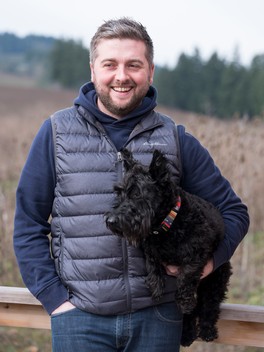Wine Webinar Wednesday
From the Grape to the Glass -- The Basic of Wine Making
In this week's webinar, we're wrapping up our foundational series on grape growing and wine making before we move into broader topics on wine history and wine regions with Sam and Thomas providing overview of the different wine making approaches for Red, White and Rosé wines.
In this session we will explain the wine maker's choices for de-stemmed vs whole cluster fermentation, the choice of fermentation vessels from stainless steel and concrete to wooden barrels, using wild vs. commercial yeasts, exactly what are "lees" and what to they contribute to wine development, what does "reduction" mean, along with a few other mysterious-sounding winemaking techniques such as "carbonic maceration" and "saignée".
This webinar is now available to Lingua Franca Club Members only.
Please click here to access the Club Member Webinar Archive Page.
Meet the Team, Part Two
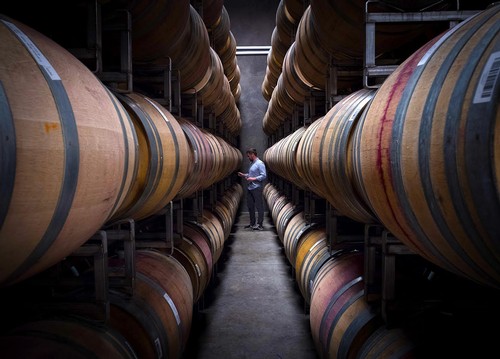
Meet Thomas Savre, Winemaker
Thomas is a native of Nancy, in northeast France. He joined Lingua Franca as our very first employee in May 2015. Prior to moving to the States, Thomas graduated from the Jules Guyot Institute at the University of Burgundy with two master’s degrees in Viticulture Practices and Enology & Winemaking. He then worked in several prestigious estates in Burgundy, including Domaine de la Romanée Conti, Domaine Dujac, among others.
So, Why Oregon?
One Saturday morning at Domaine de la Romanée Conti during the 2012 harvest, Thomas tasted a 1995 Cristom Marjorie Vineyard Pinot Noir.
"I still get goose bumps recalling the moment I tasted it for the first time. It was one of the best wines I'd ever had. That experience led me to search for wines from Oregon – anywhere and everywhere I could."
While pursuing his master's degrees in Dijon, Thomas interned for a large producer in California. It was there that he met his wife-to-be, Aimee, who was his ultimate reason for moving to the States. Eager to continue winemaking in the New World, he went on to work for Evening Land Vineyards, where he met Larry and worked side-by-side with renowned Burgundian producer Dominique Lafon. He immediately fell in love with the Eola-Amity Hills and was thrilled about the opportunity to stay when Larry approached him about planting a vineyard next door to Evening Land's Seven Springs, with Dominique overseeing as Consulting Winemaker.
What is your favorite part of your job as a winemaker?
My favorite part of the winemaking process is harvest each year. The grueling 14-hour days and non-stop physical movement are a reward months in the making — I finally get to see clusters from the vines we spend so much time carefully and diligently tending. And Oregon is always ready to throw a challenge my way, each vintage is a different experience due to both our annual weather variation and the unique place that is the Lingua Franca Estate vineyard."
As the vineyard is developing, which blocks are showing to be the most unique?
"I have worked tirelessly to understand the terroir of the Estate and make exceptional wine from the young vineyard, something I honestly believe proves the site is itself exceptional. As the vineyard evolves, I try to examine how each individual block is developing its own personality. I want to honor all of this complexity by creating single block wines, like The Plow. The Plow is sourced from the highest elevation blocks of the vineyard, where soils are shallower and there is a sharp slope. La Bête Pinot Noir is another ode to this intent, comprised of darker and more tannic fruit from the middle of the vineyard, it is a strikingly different take on the same hillside."
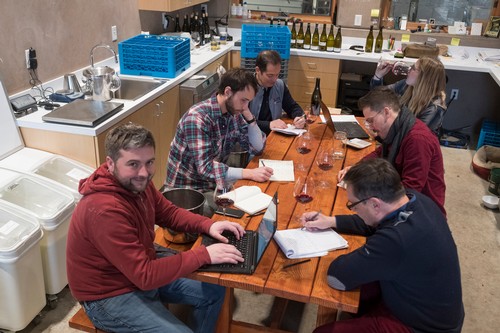 Can you tell us more about how you create the final blends every year? "When creating the blends, I really want to highlight my respect for the foundation of our site, which is the goal with our Estate wines. The parcels ferment and age separately to promote their own distinctive character before the team determines how best to create the final blends. We taste blind, in order to encourage humility for every barrel and give each parcel the chance to shine. The blind blending process improves every year as our team continues to grow alongside the vineyard. We don't always immediately agree, which is the most fun part of it all! The spirited debates remind me of the passion and dedication that we all carry with us into the cellar every day."
Can you tell us more about how you create the final blends every year? "When creating the blends, I really want to highlight my respect for the foundation of our site, which is the goal with our Estate wines. The parcels ferment and age separately to promote their own distinctive character before the team determines how best to create the final blends. We taste blind, in order to encourage humility for every barrel and give each parcel the chance to shine. The blind blending process improves every year as our team continues to grow alongside the vineyard. We don't always immediately agree, which is the most fun part of it all! The spirited debates remind me of the passion and dedication that we all carry with us into the cellar every day."
How does it feel to work so closely with some of the most prestigious names in the wine industry?
"At Lingua Franca, I have always said that I am lucky to have four dads: There's my actual father, who has always respected my decision to be a winemaker; Larry Stone, who has given me this great opportunity; Lingua Franca's co-founder and CFO David Honig; and Dominique, who has served as a life-long mentor as if I were his own son. For me this is very beautiful. I have worked hard to respect the vision of Larry using the knowledge that I have learned from Dominique."
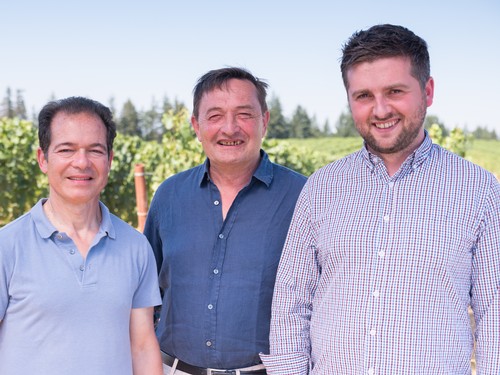
You mentioned that Dominique has served as a life-long mentor. Can you tell us a little bit about how his mentorship has influenced the winemaking at Lingua Franca?
"Dominique doesn't dictate what we do. There's a lot of trust. He respects that Oregon is unique from Burgundy and has its own sense of place. His confidence in me has allowed me to experiment with varying winemaking processes, including whole-cluster fermentation, which I mastered during my time at Domaine de la Romanée Conti. I am grateful that I have also been encouraged to bring fresh ideas and innovative tools to the table, helping to shape the future of Lingua Franca and the LF Estate Vineyard."
Finally, what do you hope to inspire among your colleagues in the wine industry?
"I want to lead by example — making honest wine and standing by our commitment to respecting the land. We must remember that winemaking is a craft, and there is no right or wrong way to do it. I am honored when people from all over the world take the time to come and taste our wine. I will never tire of sharing what we're doing and watching their emotional connection to it.
Cheers to that, Thomas.

Wine Webinar Wednesday
From Bud Break to Harvest - The Lifecycle of the Grape Vine
It's Spring in the Willamette Valley, the vines are waking from their winter nap and the growing season will begin virtually any day now. We thought this would be a great time to explain the lifecycle of the grape vine and the management techniques that are used around the world to produce high quality wine grapes. We hope you can join us for this webinar on one of the most fascinating plants on earth and how they produce such diverse and amazing wines.
This webinar is now available to Lingua Franca Club Members only.
Please click here to access the Club Member Webinar Archive Page.
Meet the Team, Part One
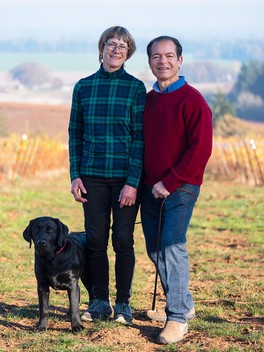
Get to Know
Larry Stone
Founder & Master Sommelier
as we share the story of Lingua Franca and some of his exclusive insights into the world of wine.
"Since my early 20s, the Willamette Valley has been the only place outside of the Cote d'Or I believed would be capable of making truly refined, vibrant and complex Pinot Noir."
Three decades ago Larry tasted the very first vintage of Seven Springs-sourced Pinot Noir, made by David Adelsheim. That bottle cemented his belief that the Eola-Amity Hills, especially between Hopewell and Zena Road, had some of the finest sites in the Willamette Valley. Years later during his tenure at Evening Land, he returned to the site that started it all. Looking across the road on that very hill, he saw what he believed was the New World equivalent of Grand Cru for both Pinot Noir and Chardonnay.
"I didn't hesitate. I sold everything to plant Lingua Franca Estate."
Larry immediately knew that it was a golden opportunity to develop an extraordinary vineyard that he says will long outlast him in the hearts of wine drinkers around the world. Click here for the full story.
 What is your current favorite everyday drinking wine, and why? My wife and I like to drink a mix of light, refreshing white, sparkling and rosé wines. Domaine de Triennes Rosé is very elegant and pretty with light fruit notes and Bisol Jeio Brut Prosecco is very dry, fresh and fine. Also, Lingua Franca L'Espoir Riesling, because it is dry and totally mouthwatering. I can drink it on its own while cooking with my wife, Nancy, or have it with a lovely sautéed salmon or halibut. For reds, I am currently drinking Lingua Franca Pinot Noir most often. Occasionally we open a bottle of Sirita Napa Cabernet Franc that I made from 1997 to 2005, named in honor of my daughter, Siri. For a fresher, more lifted version of the Cabernet family we enjoy Saumur-Champigny Cabernet Franc from the Loire Valley. For more complex and medium bodied wines I choose Chianti Selvapiana or Fattoria di Bossi for the sheer pleasure of their firm, floral, irony flavor. Also, we often open Cotes du Rhone because they are quite versatile with everything from sausages to steak - for these look for St. Cosme or Guigal, or Gigondas from Brusset.
What is your current favorite everyday drinking wine, and why? My wife and I like to drink a mix of light, refreshing white, sparkling and rosé wines. Domaine de Triennes Rosé is very elegant and pretty with light fruit notes and Bisol Jeio Brut Prosecco is very dry, fresh and fine. Also, Lingua Franca L'Espoir Riesling, because it is dry and totally mouthwatering. I can drink it on its own while cooking with my wife, Nancy, or have it with a lovely sautéed salmon or halibut. For reds, I am currently drinking Lingua Franca Pinot Noir most often. Occasionally we open a bottle of Sirita Napa Cabernet Franc that I made from 1997 to 2005, named in honor of my daughter, Siri. For a fresher, more lifted version of the Cabernet family we enjoy Saumur-Champigny Cabernet Franc from the Loire Valley. For more complex and medium bodied wines I choose Chianti Selvapiana or Fattoria di Bossi for the sheer pleasure of their firm, floral, irony flavor. Also, we often open Cotes du Rhone because they are quite versatile with everything from sausages to steak - for these look for St. Cosme or Guigal, or Gigondas from Brusset.
What's the best advice you can offer to those looking to expand their palate using only their neighborhood wine shop? When buying wine in a store I find that a little trust is usually repaid. Work with the staff, explain what you have enjoyed before and ask questions. Try regions and vintages you have not yet tasted, as it's the best way to expand your knowledge.
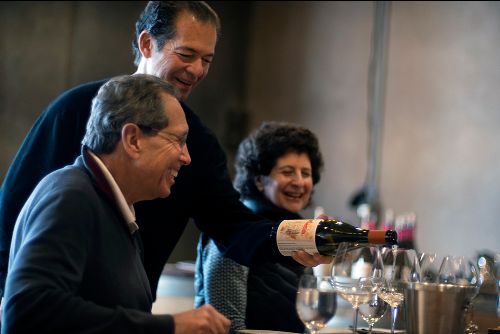
What are your most essential tools for enjoying wine at home? Besides my Cartailler-Deluc Model 92 corkscrew, it could only be my Riedel Sommelier Burgundy wine glass.
Tell us about a producer that you enjoy and would like to see more people drinking. Sohm & Kracher Grüner Veltliner from Austria is refreshing with a note of salinity, white pepper, and lemon zest. Made by one of the finest winemakers in the world and one of the world's best sommeliers, Aldo Sohm. His two most accessible types are the inexpensive and delicious "Lion", fermented and aged in stainless steel, and then the serious "Alte Reben" aged in stainless steel before being transferred to wooden casks of Slovenian oak.
Which wineries in the Willamette Valley should we also visit when planning a trip to Lingua Franca? There are many great wineries in the Willamette Valley, but try Cristom, Brooks, Walter Scott, Bergström, Beaux Frères, Brick House, Soter, Domaine Drouhin, Antica Terra, and Evening Land. Click here to view our availability and make a reservation.
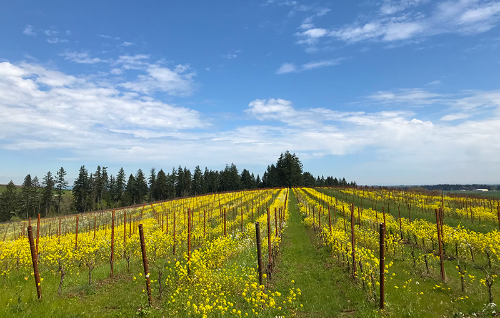 Finally, given the story of how you came to find this specific site, what about the future of the Lingua Franca Estate vineyard most excites you? The most exciting thing about the Lingua Franca Estate vineyard has been how it has evolved so quickly to become our finest source of fruit. While it started out strong, Lingua Franca Estate has appreciably gained depth and complexity each of the four consecutive vintages we have harvested from it. As we release the 2018 vintage, the quality of flavors and the intensity of the wine are astonishing. In fact, each block seems to gain more character and personality every year, so I am curious to see what they will do in the years to come.
Finally, given the story of how you came to find this specific site, what about the future of the Lingua Franca Estate vineyard most excites you? The most exciting thing about the Lingua Franca Estate vineyard has been how it has evolved so quickly to become our finest source of fruit. While it started out strong, Lingua Franca Estate has appreciably gained depth and complexity each of the four consecutive vintages we have harvested from it. As we release the 2018 vintage, the quality of flavors and the intensity of the wine are astonishing. In fact, each block seems to gain more character and personality every year, so I am curious to see what they will do in the years to come.
Wine Webinar Wednesday
Roll out the Barrel - The Role of Wood in Wine Making
In this webinar episode, we discuss the how wine barrels are used in the wine making process, where barrel wood comes from, how American and European (French) oak differ, and how barrels are made.
This webinar is now available to Lingua Franca Club Members only.
Please click here to access the Club Member Webinar Archive Page.
Wine Webinar Wednesday
A Profound Sense of Place - Understanding the Concept of Terroir
In our first Wine Wednesday Webinar, we discuss the environmental factors that make up the concept of terroir and how they influence the personality of the grape and the wines you enjoy.
This webinar is now available to Lingua Franca Club Members only.
Please click here to access the Club Member Webinar Archive Page.
